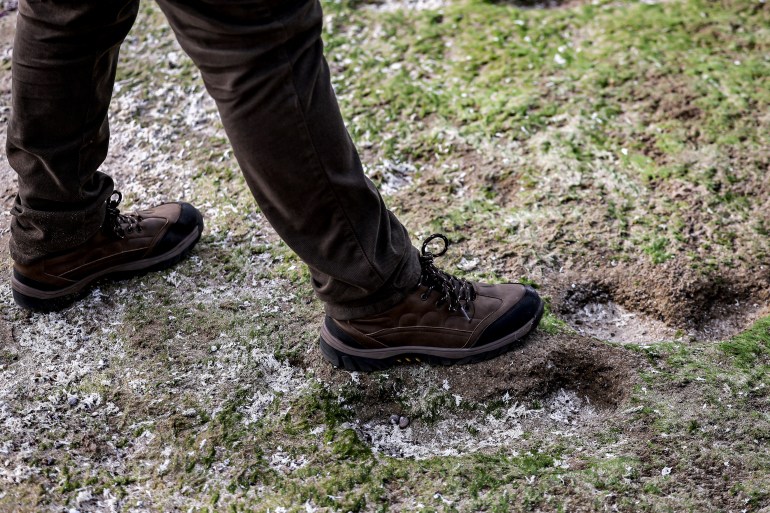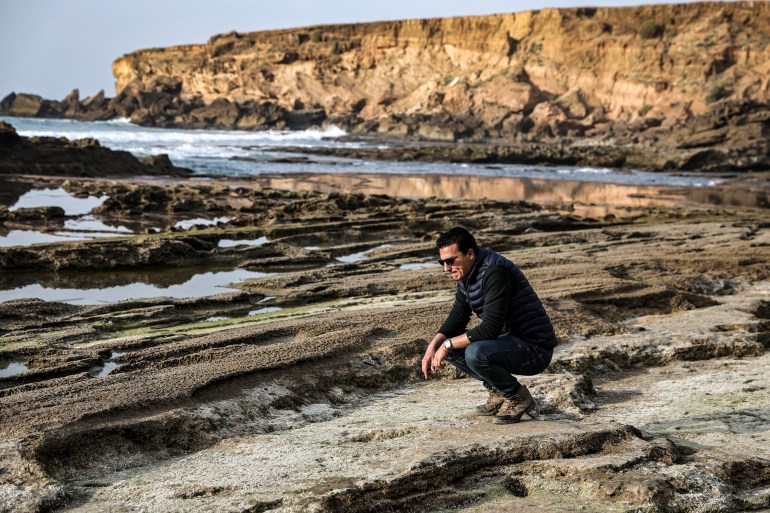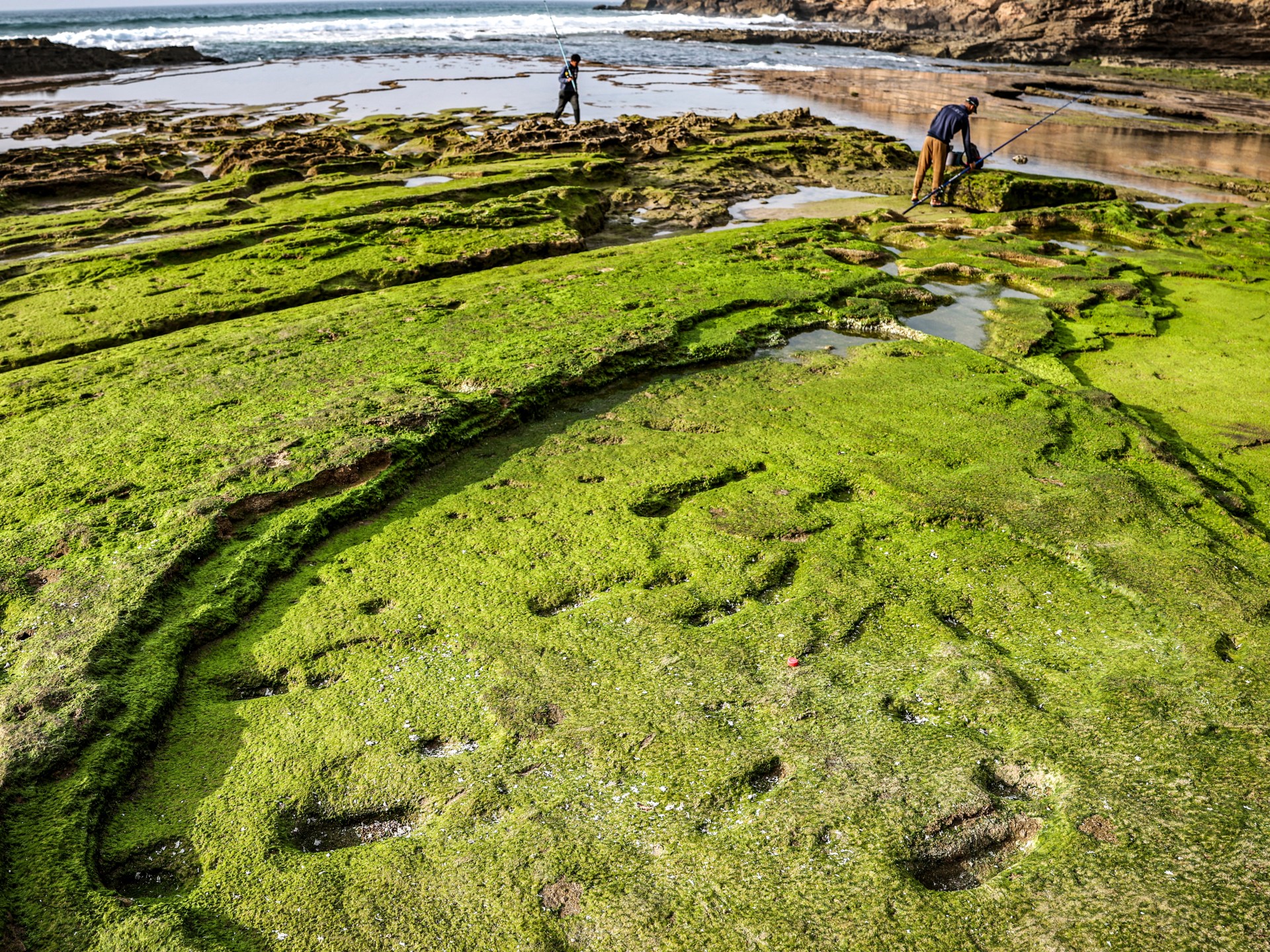What 100,000-year-old footprints in Morocco inform us about early people | Science and Expertise Information [World]
[ad_1]
What can indentations within the floor from ages in the past inform us about our early ancestors? Loads, it seems.
In January, a world workforce of scientists from Morocco, France, Germany and Spain printed particulars of an enchanting discovery: a set of well-preserved human footprints believed to be 100,000 years outdated.
The footprints are considered from a gaggle of 5 people and have been discovered on a rocky seashore in a northern Moroccan city.
The analysis, printed within the science journal Nature, provides to a rising physique of labor that’s serving to scientists piece collectively the evasive, true origins of the human race. However whereas their discovery is an archaeological feat, coastal erosion threatens the existence of those historic tracks.
Right here’s what we learn about this newest discover and about different historic human traces that scientists have found thus far.

What did scientists discover in Morocco?
In June 2022, archaeologist Mouncef Sedrati was main subject analysis centered on boulders near the Moroccan shoreline in an space south of Tangier when his workforce chanced on indentations within the floor on the metropolis of Larache.
On nearer look, they found the indentations have been footprints of various sizes. To Sedrati, a coastal dynamics and marine geology knowledgeable at France’s College of Southern Brittany, it was an “distinctive” sight.
“We weren’t 100% positive at first with the primary print, however little by little, we discovered a second, third, then a really clear trackway and increasingly more,” Sedrati advised Al Jazeera.”That’s when the doubt disappeared. The preliminary traces have been left by wholesome Homo [sapiens] on a sandy seashore sediment round 100,000 years in the past.”
About 85 footprints have been present in whole, probably made by a gaggle of 5 people who have been strolling in the direction of the water, utilizing the positioning as a path. These are the primary early human tracks to have been found in North Africa and the Southern Mediterranean.
The arch of the indentations, rounded heels and the marks of brief toes confirmed that they have been tracks from Homo sapiens or fashionable people like us. Their various foot sizes instructed there have been adults and youngsters of various ages.
The scientists, although, nonetheless have no idea what the group was doing on the location. Have been they attempting to collect meals from the ocean? Or have been they merely navigating by means of the realm and got here throughout the seashore route by likelihood?
Sedrati’s workforce studied sediment within the location and the footprints themselves to find out how lengthy they may have been there.
Optically stimulated luminescence courting, a analysis method that helps archaeologists decide when the minerals or carbon surrounding found artefacts have been final uncovered to warmth or daylight, allowed the researchers to estimate how outdated the prints could be.
They pegged the origins of the marks to the Late Pleistocene period, the interval throughout which the final Ice Age occurred. The previous Center to Late Pleistocene, encompassing the intervals from 770,000 to 120,000 years in the past, is broadly believed to be the age when historic people – separate from fashionable people – roamed the earth.
Utilizing a drone to take 461 pictures of the prints, the workforce processed the pictures utilizing specialised software program and extracted 3D fashions to precisely measure the despair and width of every print, and to gauge the ages of the group’s members.
The Larache footprints probably remained intact due to a mixture of things, the researchers wrote within the research, together with their location, the soil sort and the ocean waves. The place of the seashore on a rocky platform allowed the tides to bury the clay sediments forming the tracks, maintaining them preserved till a current erosion uncovered them once more.
For Sedrati, who’s of North African descent, the invention is private.
“You possibly can think about how proud I’m to steer the analysis workforce that made this discovery, much more so in a Moroccan metropolis that’s near my coronary heart,” he stated, including that he relished working with colleagues from different fields like geology to finish the research.
However there’s extra work for the workforce to do. Solely a part of the prints have been processed, and the workforce has questions.
“What have been the climatic and meteorological circumstances of the time? The place was the shoreline, the ocean degree?” Sedrati requested.

The place else have historic human tracks been discovered?
Discovering footprints which might be hundreds of years outdated is uncommon however not exceptional.
The oldest recognized human tracks have been found in 1995. These have been a set of three imprints belonging to a hypothetical “Eve” and referred to as “Eve’s footprints”. They have been found in Langebaan, a coastal city in South Africa’s West Cape province. “Eve” was thought to have lived about 117,000 years in the past.
David Roberts, who fashioned a part of the workforce that found these prints, stated on the time that they have been probably made on a steep dune throughout a storm earlier than dry sand crammed the indentation and hardened.
The prints measured 22cm (8.7 inches), about the identical dimension as a contemporary girl sporting a US dimension 7.5. “Eve” was most likely about 122cm (4ft) tall.
In 2022, one other workforce of researchers discovered two human tracks on the roof of a collapse the identical space. They weren’t well-preserved. The sediment the imprints had been made in had eroded, however the outlines of the footprints have been nonetheless seen. The space between the 2 tracks – 49cm (19 inches), according to the space between a median human’s legs whereas striding – instructed to the workforce that it was from one among our direct ancestors, fairly than Hominini – one other species of the fashionable human that’s now extinct.
Past the African continent, historic tracks have additionally been found in the USA. In 2009, a park supervisor in White Sands Nationwide Park, New Mexico, discovered a footprint and led scientists to uncover hundreds extra unfold over 325sq km (80,000 acres). These included child-sized footprints, and one set particularly confirmed a lady probably setting down a child. Researchers in 2021 stated they have been probably made 22,800 years in the past.

What do these findings inform us about prehistoric people?
Paleoanthropologists – researchers finding out the evolution of the fashionable human – stated the prints collectively current us with a snapshot in time, serving to us decide what life might need been like for our early ancestors.
One risk, for instance, is that historic females painted their our bodies with elements much like fashionable make-up: Scientists who found Eve’s footprints additionally discovered ochre, a vibrant pigment, in the identical space. It’s believed the physique paint was utilized for rituals.
At different occasions, scientists have discovered hearths – indicating that older people knew tips on how to mild fires. Bone stays and stone instruments additionally level to the likelihood that early people first relied on lifeless animals for meals and might need solely began to set traps and hunt animals about 20,000 years in the past.
However footprints additionally give scientists an estimated timeframe to work out when people began branching out and transferring throughout the globe.
For years, researchers held that fashionable people first arrived in Alaska and unfold by means of North America about 13,000 to 16,000 years in the past after the final Ice Age.
However the footprints within the New Mexico White Sands Park disproved these research. Within the new state of affairs, people have been already spreading round New Mexico, and probably travelled by means of the continent 23,000 years in the past when glaciers have been nonetheless increasing and spreading by means of the realm.
Sadly, many of those discoveries, together with the White Sands and Larache prints, are threatened by altering topography, partly linked to a altering local weather. Sedrati’s group famous in its research that the rocky shore is collapsing from rising sea ranges and that it might finally disappear.

![Yemen’s Houthis say 17 rebels killed in US-led assaults | Houthis Information [World]](https://officialsarkar.in/wp-content/uploads/2024/02/AFP__20240210__34J49LD__v3__HighRes__YemenUsBritainShippingConflict-1-1707583848-768x576.jpg)
![Qatar to ICJ: Israel carrying out “genocidal war” on people of Gaza | Israel War on Gaza [World]](https://officialsarkar.in/wp-content/uploads/2024/02/AA-20240223-33793800-33793799-ICJ_HOLDS_PUBLIC_HEARINGS_IN_ADVISORY_PROCEEDING_ON_STATE_OF_PALESTINE-1708718552-768x576.jpg)
![UN says acute malnutrition spreading fast among children in Gaza | Israel War on Gaza News [World]](https://officialsarkar.in/wp-content/uploads/2024/03/AFP__20240311__34L88WD__v4__HighRes__TopshotPalestinianIsraelConflictReligionIslamRa-1710592682-768x576.jpg)
![The constructive tales Afghanistan wants | Opinions [World]](https://officialsarkar.in/wp-content/uploads/2024/02/AFP__20231024__33YY3ZE__v1__HighRes__AfghanistanEducationSchool-1707574429-768x576.jpg)
![It is time for a new Africa beyond borders and boundaries | African Union [World]](https://officialsarkar.in/wp-content/uploads/2024/02/doc-34h82jh-1708089194-768x576.jpg)
![Taliban releases Austrian far-right activist held in Afghanistan | Politics News [World]](https://officialsarkar.in/wp-content/uploads/2024/02/2024-02-25T180022Z_319297724_RC2R96AZ6Q62_RTRMADP_3_AUSTRIA-HOSTAGE-QATAR-1708887914-768x576.jpg)